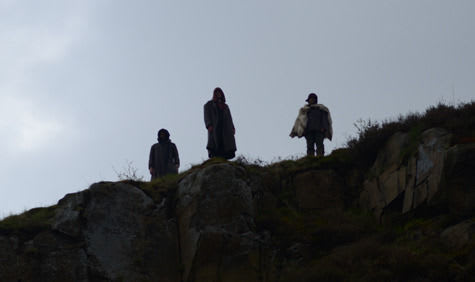This ambitious 90-minute adaptation of Shakespeare’s play is presented in what director, choreographer and set designer Judith Roberts calls three languages: English, Welsh and Dance.
In fact there are more with music and video contributing throughout and at some points apparently text in Polish and Hebrew. It is a complex amalgam in which five performers play all the roles which are essentially Macbeth and his Lady and the three witches, who also play Banquo, Malcolm and Macduff.
Shakespeare’s heavily-cut text is used in English and in Welsh translation and I doubt whether anyone not already familiar with the play would be able to get much idea of the story—not because of the two tongues but because although it follows its outline, retaining some of the main soliloquies, it has been so pared down.
The movement and dance elements, apart from the final fight between Macduff and Macbeth, do not seem intended to carry narrative but express the complex relationship between Macbeth and Lady Macbeth.
The setting, made up of three big triangular boxes like black cheese wedges and frontal hanging gauzes, is dominated by a rear cloth on which a video montage is projected. Those images, and others on the gauzes, tend to dominate the stage, drawing attention from performers seen under emotive chiaroscuro lighting.
The wedges, manhandled into positions to suggest hovels or a cave, cliffs or battlements and banquet tables, are toppled to make loud crashes at points of tension, a more dramatic sound that most of Conor Linehan’s music for string quartet, which forms an almost continuous ground through speeches and movement but rarely seems to have much connection with what is happening in the drama.
A video of a grey and brooding landscape across which three figures approach begins the piece. They could be Macbeth and Banquo returning after battle with another or the witches. When they halt above a steep escarpment, three similarly hooded figures emerge from a cluster of shapes that could be a cave or hut and they seem to be the witches.
Shedding their outer garments they can become Banquo, Malcolm and Macduff as needed. The action does not make it entirely clear whether this is a change of role or whether they too are controlled by the occult as the Macbeths appear to be in a complex choreography of swirling arms and lifts that entangles them with the witches, as a snake winds forwards and then strikes and retreats in slow motion in the huge image behind them.
There is striking choreography, as witches wriggle forward beneath mounds of gauze, as Macbeth is carried, clutching blood-dripping daggers, across the hunched backs of the witches or when Lady Macbeth is lifted high by them.
While Eddie Ladd’s Lady Macbeth, speaking I believe largely in Welsh, is vocally dramatic, Gerald Tyler’s Macbeth is calmly and deliberately spoken. Unlike some of the text spoken by others, it is very clear but delivered almost word by word with drained feeling. Is this to suggest that he is under supernatural control? Their voices are used with an intriguing effect as when Lady Macbeth delivers her invocation to “un-sex me here”, her husband murmurs the words in English on the other side of the stage a moment later.
I found the video too distracting, wondering whether the slowed down striking snake recoiled or the recording reversed, how explosions of burning oil or a close up of an owl fitted the action or what it was that was being shown in a long sequence with an attention grabbing twitch. I probably missed some interesting and possibly informative action taking place downstage because of them.
When used, however, to present the witches as huge male faces projected on the downstage gauzes or the apparitions that they show Macbeth, they are especially effective. I am all for mingling the elements of theatre and finding ways of playing to two language groups at the same time, but the different tools of theatre must be used to support or complement each other not be in conflict unless that is the deliberate intention.
With Gwyn Emberton, Matthew Harries and Sean Palmer as the witches, this is a talented company that moves from stillness to whirling action. At times, Judith Roberts has succeeded in suggesting something unnatural and powerful emanating from the dark landscape, but moments too when you wonder what on earth is supposed to be going on—and there must be more of them if you do not already know the story.
I got the feeling this is a work in progress that needs more shaping and a score that, whatever its musical merits, contributes more to the dramatic effect.
